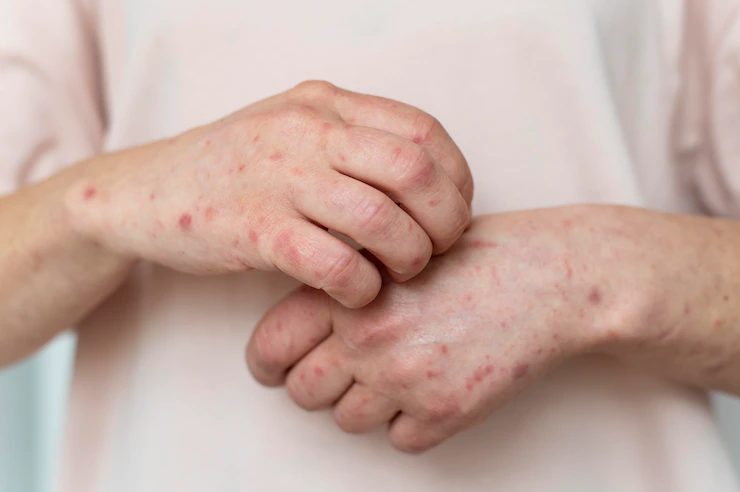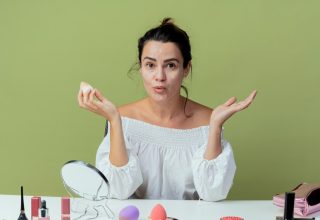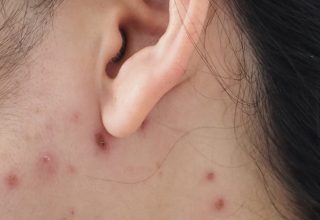What Are The Different Types of Eczema
Eczema is a term used to generally describe a group of chronic skin conditions that causes inflammation, swelling, redness, discoloration, and skin irritation.
While the condition is common in childhood, anyone can get it. However, eczema is not contagious, meaning no one can catch it or pass it to others.
There are different types of eczema, with some more common than others. But on the whole, the condition affects over 30 million people in the US.
Researchers don’t know what causes eczema, but they know that it’s related to genes, the environment, and the immune system. And while there’s no cure for the disease, patients can manage symptoms with a proper treatment plan and medical care.
This article will discuss different types of eczema, causes, and treatment options.
Contents
1. Atopic Dermatitis
This is the most common and severe type of eczema patients suffer from. It also lasts the longest, affecting over 26 million Americans.
Atopic dermatitis often begins in infancy and gets milder as patients get older. Many patients with atopic dermatitis suffer from asthma and hay fever.

Symptoms
- Red, scaly and itchy skin, especially on the back of the knees and insides of the elbows
- Rashes on the cheeks or scalp
- Oozing or clear fluid from the scratching
- Cracking skin
- Crusting and infection-prone skin
Causes
Doctors and researchers still don’t know what causes atopic dermatitis, but they believe its usually a combination of genetics and environmental triggers such as:
- cold weather, low humidity, and extreme temperature changes
- irritants, such as household detergents, soaps, shampoos, perfumes, etc
- food allergies
- dust mites or animal hair
- Certain materials, including wool, nylon, polyester
- skin infections, like scabies
- hormonal changes
Tracking these triggers can help identify ways to prevent flare-ups.
For atopic dermatitis treatment, experts often recommend using topical creams and moisturizers to keep the skin healthy. They may suggest that patients take antihistamines or make bathing and dietary changes. Atopic dermatitis injection is often recommended in mild to severe cases.
2. Dyshidrotic Eczema
Dyshidrotic eczema, also called pompholyx, is a type of eczema that affects the palms of the hands, fingers, and soles of the feet.
It affects adults between 20 and 40, especially those with seasonal allergies.

Symptoms
- Intense itching
- Fluid-filled blisters
- Pain, swelling, or redness around the blisters
- Burning sensation and prickling feelings around the affected area
The blisters typically clear up within 1-2 weeks, often causing dry and cracked skin around the areas.
Causes
It is most common in people with:
- Exposure to chromium, nickel, or cobalt
- Exposure of hands and feet to too much water or dump environment
- Hay fever
- Atopic dermatitis
- Fungal infections
- Emotional stress
Treatment includes inhibitor creams or steroid ointments to manage itchiness and treat symptoms. Doctors may also suggest draining the blisters or treating skin using ultraviolet light to help reduce swelling and pain.
3. Nummular Eczema
Nummular eczema, also known as discoid eczema, is often recognizable due to its disc or coin-shaped patches of red, itchy, swollen, and cracked skin that it causes.
The discs usually appear on the forearms, lower legs, and torso. Sometimes, the discs clear up, leaving patches of red skin.

Symptoms
Nummular eczema can sometimes be mistaken for conditions like psoriasis, ringworms, or fungal infections.
Patients can develop a single patch of discoid eczema or multiple at once.
Symptoms include:
- Round, coin-shaped patches of red skin
- Itchy or inflamed skin
- Crusty skin
Causes
Like other types of eczema, the causes of nummular eczema are not fully known. However, common risk factors and triggers include:
- dry skin
- skin injuries, such as burns or friction
- poor blood flow
- insect bites
- bacterial infections
- Some medications
- cold climate
- atopic dermatitis
Treatment may include antihistamines and topical steroids to treat the patches on the skin. Experts may also recommend gentle household detergents like soaps and short baths to protect the skin barrier.
4. Contact Dermatitis
Some people get skin irritation when they come into contact with particular substances or materials. This is referred to as contact dermatitis.

Symptoms
Contact dermatitis affects people who frequently touch irritants, chemicals, or allergens like health care workers and hairstylists.
While it’s not contagious, it can be quite uncomfortable. Common symptoms include:
- dry, red, and itchy skin with a burning sensation
- blisters
- hives, rashes that consist of small, red bumps
Causes
There are two types of contact dermatitis: allergic and irritant contact dermatitis.
Irritant contact dermatitis is more common, having up to 80% of cases. It occurs when individuals come into regular contact with substances that irritate the skin, including:
- Harsh household detergents
- Acids and alkalis
- Hair dyes
- Cobalt or nickel
- Solvents
- Cement
Some people also develop irritant contact dermatitis from repeated exposure of their hands to hot water.
Allergic contact dermatitis occurs when an individual comes into contact with substances that trigger an immune response.
Possible triggers include:
- Some fabrics
- Fragrances
- Clothing dyes
- Some plants like poison oak, poison ivy, and sumac
- Certain medications such as topical medicines and oral antibiotics
- Some metals like nickel and cobalt
- Ingredients in some creams, makeup, nail polishes, hair dyes, etc
Health professionals will often prescribe topical steroids or suggest moisturizing ointments for irritant contact dermatitis. They may also recommend oral corticosteroids or antihistamines for allergic contact dermatitis.
5. Varicose Eczema
Also known as stasis dermatitis, venous or gravitational eczema. It occurs when patients have poor blood flow, or circulation, in their legs.
Varicose eczema is common in adults with varicose veins and affects up to 20 million older people in the United States alone.
Getting older and becoming less active can sometimes weaken the veins preventing them from efficiently pumping the blood in the legs. When that happens, legs swell, and fluid leaks into the feet, ankles, and legs.

Symptoms
- burning, itchy spots, or blisters
- scaly, dry skin
- leaking, crusty patches
- Shiny skin
- cracked skin
Varicose eczema can affect one or both legs at the same time, but it rarely affects other areas of the body.
Causes
Varicose eczema is commonly associated with poor blood circulation in the lower legs. If the blood can no longer be pushed up through the legs toward the heart, blood can pool in the lower legs, causing swelling and forming varicose veins.
When to Seek Medical Attention
Any symptom on the skin that feels excessive, intense, or interrupts your daily life deserves immediate medical attention.
If you notice a rash, itchy, tender, or painful skin patch or any other skin condition that won’t clear up or gets worse, even with home remedies or over-the-counter medications, schedule an appointment with a healthcare professional to examine and diagnose it for proper treatment. These may be signs of a skin condition that could become life-threatening without treatment. Sign in to get valuable health information.
Additionals:
- 10 Ways Chiropractic Care Can Enhance Your Health
- How Loneliness Harms Your Physical And Mental Health
- 8 Ways Probiotic Skin Treatments Can Restore Your Glow
- Lightening Your Skin Safely: Avoid These Practices and Ingredients


